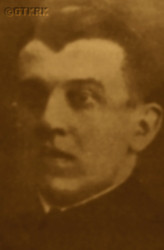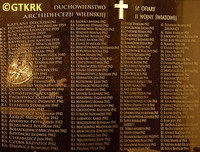Roman Catholic
St Sigismund parish
05-507 Słomczyn
85 Wiślana Str.
Konstancin deanery
Warsaw archdiocese, Poland
full list:
displayClick to display full list

searchClick to search full list by categories
wyświetlKliknij by wyświetlić pełną listę po polsku

szukajKliknij by przeszukać listę wg kategorii po polsku

Martyrology of the clergy — Poland
XX century (1914 – 1989)
personal data
surname
STASZELIS
forename(s)
Stanislav (pl. Stanisław)
function
diocesan priest
creed
Latin (Roman Catholic) Church RCmore on
en.wikipedia.org
[access: 2014.09.21]
diocese / province
Vilnius archdiocesemore on
en.wikipedia.org
[access: 2013.05.19]
Vilnius diocesemore on
en.wikipedia.org
[access: 2013.05.19]
RC Military Ordinariate of Polandmore on
en.wikipedia.org
[access: 2014.12.20]
date and place
of death
02.07.1941

Survilishkitoday: Traby ssov., Ivye dist., Grodno reg., Belarus
more on
be.wikipedia.org
[access: 2023.01.18]
details of death
In 1927 and 1929 appointed reserve chaplain of the Polish Army (first time by order of the President of the Republic of Poland of 01.09.1927, with seniority from 01.01.1927 and 365th place among the Roman Catholic military clergy; each time for a statutory 2‐year period).
After German and Russian invasion of Poland in 09.1939 and start of the World War II, after German attack on 22.06.1941 of their erstwhile ally, Russians, after capture of Surwiliszki by the German army, murdered at rectory together with all residents by the German soldiers.
An almost a week–long German–Russian battle was being concluded — e.g. 23‐27.06.1941 at Raseiniai — and apparently some Russian military uniforms were found in the rectory…
cause of death
mass murder
perpetrators
Germans
sites and events
Ribbentrop‐MolotovClick to display the description, Pius XI's encyclicalsClick to display the description
date and place
of birth
20.05.1898

Tverečiustoday: Tverečius eld., Ignalina dist., Utena Cou., Lithuania
more on
en.wikipedia.org
[access: 2021.12.18]
presbyter (holy orders)
ordination
14.06.1924

positions held
1936 – 1941
parish priest — Survilishkitoday: Traby ssov., Ivye dist., Grodno reg., Belarus
more on
be.wikipedia.org
[access: 2023.01.18] ⋄ Holy Trinity RC parish ⋄ Vishnyevatoday: Vishnyeva ssov., Valozhyn dist., Minsk reg., Belarus
more on
en.wikipedia.org
[access: 2021.09.29] RC deanery
c. 1939
administrator — Norviliškėstoday: Dieveniškės eld., Šalčininkai dist., Vilnius Cou., Lithuania
more on
en.wikipedia.org
[access: 2021.12.18] ⋄ Blessed Virgin Mary Mother of Mercy RC parish ⋄ Ashmyanytoday: Ashmyany dist., Grodno reg., Belarus
more on
en.wikipedia.org
[access: 2020.11.27] RC deanery
1932 – 1936
parish priest — Lebedevotoday: Lebedevo ssov., Maladzyechna dist., Minsk reg., Belarus
more on
be.wikipedia.org
[access: 2023.01.18] ⋄ Nativity of the Blessed Virgin Mary RC parish ⋄ Vileykatoday: Vileyka dist., Minsk reg., Belarus
more on
en.wikipedia.org
[access: 2022.01.06] RC deanery
1927 – 1932
parish priest — Daukszyszkitoday: part of Doilidky village, Gervyaty ssov., Astravyets dist., Grodno reg., Belarus
more on
be.wikipedia.org
[access: 2022.01.06] ⋄ Intercession of the Blessed Virgin Mary RC parish ⋄ Ashmyanytoday: Ashmyany dist., Grodno reg., Belarus
more on
en.wikipedia.org
[access: 2020.11.27] RC deanery
1926 – 1927
curatus/rector/expositus — Alionystoday: Alionys eld., Širvintos dist., Vilnius Cou., Lithuania
more on
lt.wikipedia.org
[access: 2022.01.06] ⋄ Immaculate Conception of the Blessed Virgin Mary RC church ⋄ Paberžėtoday: Paberžė eld., Vilnius dist., Vilnius Cou., Lithuania
more on
en.wikipedia.org
[access: 2022.01.06], Sacred Heart of Jesus RC parish ⋄ Vilniustoday: Vilnius city dist., Vilnius Cou., Lithuania
more on
en.wikipedia.org
[access: 2022.01.06] RC deanery
1926
vicar — Dzyatlavatoday: Dzyatlava dist., Grodno reg., Belarus
more on
en.wikipedia.org
[access: 2022.01.06] ⋄ Assumption of the Blessed Virgin Mary RC parish ⋄ Slonimtoday: Slonim dist., Grodno reg., Belarus
more on
en.wikipedia.org
[access: 2021.09.29] RC deanery
1924 – 1926
vicar — Ashmyanytoday: Ashmyany dist., Grodno reg., Belarus
more on
en.wikipedia.org
[access: 2020.11.27] ⋄ St Michael the Archangel RC parish ⋄ Ashmyanytoday: Ashmyany dist., Grodno reg., Belarus
more on
en.wikipedia.org
[access: 2020.11.27] RC deanery
student — Vilniustoday: Vilnius city dist., Vilnius Cou., Lithuania
more on
en.wikipedia.org
[access: 2022.01.06] ⋄ Department of Theology, Stephen Batory University [i.e. Vilnius University (from 1945) / some faculties acting clandestinely (1939‐1945) / closed by Lithuanians (1939) / Stephen Batory University (1919‐1939)]
till 1924
student — Vilniustoday: Vilnius city dist., Vilnius Cou., Lithuania
more on
en.wikipedia.org
[access: 2022.01.06] ⋄ philosophy and theology, Theological Seminary
sites and events
descriptions
Ribbentrop‐Molotov: Genocidal Russian‐German alliance pact between Russian leader Joseph Stalin and German leader Adolf Hitler signed on 23.08.1939 in Moscow by respective foreign ministers, Mr. Vyacheslav Molotov for Russia and Joachim von Ribbentrop for Germany. The pact sanctioned and was the direct cause of joint Russian and German invasion of Poland and the outbreak of the World War II in 09.1939. In a political sense, the pact was an attempt to restore the status quo ante before 1914, with one exception, namely the „commercial” exchange of the so‐called „Kingdom of Poland”, which in 1914 was part of the Russian Empire, fore Eastern Galicia (today's western Ukraine), in 1914 belonging to the Austro‐Hungarian Empire. Galicia, including Lviv, was to be taken over by the Russians, the „Kingdom of Poland” — under the name of the General Governorate — Germany. The resultant „war was one of the greatest calamities and dramas of humanity in history, for two atheistic and anti‐Christian ideologies — national and international socialism — rejected God and His fifth Decalogue commandment: Thou shall not kill!” (Abp Stanislav Gądecki, 01.09.2019). The decisions taken — backed up by the betrayal of the formal allies of Poland, France and Germany, which on 12.09.1939, at a joint conference in Abbeville, decided not to provide aid to attacked Poland and not to take military action against Germany (a clear breach of treaty obligations with Poland) — were on 28.09.1939 slightly altered and made more precise when a treaty on „German‐Russian boundaries and friendship” was agreed by the same murderous signatories. One of its findings was establishment of spheres of influence in Central and Eastern Europe and in consequence IV partition of Poland. In one of its secret annexes agreed, that: „the Signatories will not tolerate on its respective territories any Polish propaganda that affects the territory of the other Side. On their respective territories they will suppress all such propaganda and inform each other of the measures taken to accomplish it”. The agreements resulted in a series of meeting between two genocidal organization representing both sides — German Gestapo and Russian NKVD when coordination of efforts to exterminate Polish intelligentsia and Polish leading classes (in Germany called «Intelligenzaktion», in Russia took the form of Katyń massacres) where discussed. Resulted in deaths of hundreds of thousands of Polish intelligentsia, including thousands of priests presented here, and tens of millions of ordinary people,. The results of this Russian‐German pact lasted till 1989 and are still in evidence even today. (more on: en.wikipedia.orgClick to attempt to display webpage
[access: 2015.09.30])
Pius XI's encyclicals: Facing the creation of two totalitarian systems in Europe, which seemed to compete with each other, though there were more similarities than contradictions between them, Pope Pius XI issued in 03.1937 (within 5 days) two encyclicals. In the „Mit brennender Sorge” (Eng. „With Burning Concern”) published on 14.03.1938, condemned the national socialism prevailing in Germany. The Pope wrote: „Whoever, following the old Germanic‐pre‐Christian beliefs, puts various impersonal fate in the place of a personal God, denies the wisdom of God and Providence […], whoever exalts earthly values: race or nation, or state, or state system, representatives of state power or other fundamental values of human society, […] and makes them the highest standard of all values, including religious ones, and idolizes them, this one […] is far from true faith in God and from a worldview corresponding to such faith”. On 19.03.1937, published „Divini Redemptoris” (Eng. „Divine Redeemer”), in which criticized Russian communism, dialectical materialism and the class struggle theory. The Pope wrote: „Communism deprives man of freedom, and therefore the spiritual basis of all life norms. It deprives the human person of all his dignity and any moral support with which he could resist the onslaught of blind passions […] This is the new gospel that Bolshevik and godless communism preaches as a message of salvation and redemption of humanity”… Pius XI demanded that the established human law be subjected to the natural law of God , recommended the implementation of the ideal of a Christian state and society, and called on Catholics to resist. Two years later, National Socialist Germany and Communist Russia came together and started World War II. (more on: www.vatican.vaClick to attempt to display webpage
[access: 2023.05.28], www.vatican.vaClick to attempt to display webpage
[access: 2023.05.28])
sources
personal:
www.bialystok.opoka.org.plClick to attempt to display webpage
[access: 2013.01.06]
bibliographical:
„Vilnius archdiocese clergy martyrology 1939‐1945”, Fr Thaddeus Krahel, Białystok, 2017
original images:
www.ciekawepodlasie.plClick to attempt to display webpage
[access: 2020.07.31]
LETTER to CUSTODIAN/ADMINISTRATOR
If you have an Email client on your communicator/computer — such as Mozilla Thunderbird, Windows Mail or Microsoft Outlook, described at WikipediaPatrz:
en.wikipedia.org, among others — try the link below, please:
LETTER to CUSTODIAN/ADMINISTRATORClick and try to call your own Email client
If however you do not run such a client or the above link is not active please send an email to the Custodian/Administrator using your account — in your customary email/correspondence engine — at the following address:

giving the following as the subject:
MARTYROLOGY: STASZELIS Stanislav
To return to the biography press below:
 Click to return to biography
Click to return to biography









